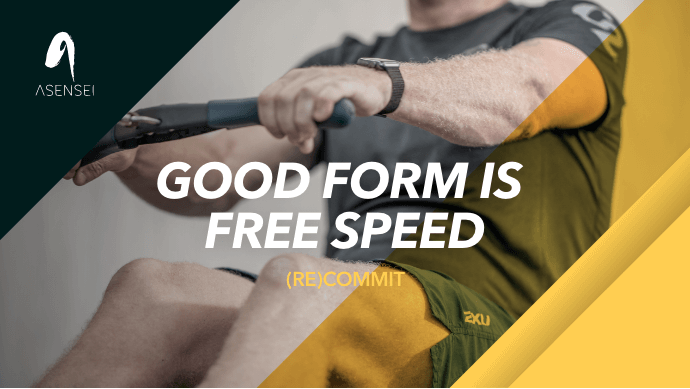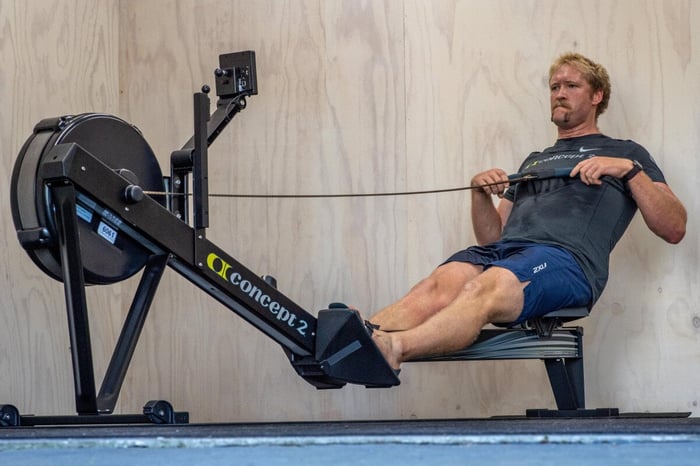Feet out rowing, you might have heard of it, but what is it and why do people choose to row without footstraps over their feet? What are the benefits and what should you watch out for when rowing with your feet out? Today’s coaching gold tip is inspired by one of coach Eric Murray’s livestream workouts from Dec 2020, when many parts of the world were locked down due to the COVID-19 pandemic and our community livestreams were a great way of keeping fit, keeping in touch with other rowers and of course improving your rowing. One of the participants, J Lo (could it be?!) asked about the advantages of rowing without your foot straps over your feet.
Thankfully lockdowns are no more but the livestreams continue to this day.
The asensei youtube channel features livestream workouts from coach Eric Murray every week which are packed with insights and tips from one of rowing's all-time greats. In the Coaching Gold series we will highlight some of Eric's tips and insights from his Q&A sessions at the end of each workout and from webinars. This time we ask why row without foot straps - what are the benefits and when should you give it a try?
Table of Contents
- Why row without foot straps - what's the benefit?
- What to watch out for when rowing with feet out of the straps?
- When should your row with your feet out of the straps?
- How to incorporate feet-out rowing in an actual workout
- Conclusion: Feet-out rowing
- FREQUENTLY ASKED QUESTIONS
- DOWNLOAD ASENSEI TODAY
Why row without foot straps - what's the benefit?
Why row without foot straps? Eric explains that a lot of people like to row feet out, which means you have got to engage your core to ensure you have a good finish position, rather than relying on the straps to restrain you during layback and to help start the recovery phase of the stroke. This does naturally work the core abdominal muscles a little harder than when you are rowing straps-in.
The biggest benefit from rowing straps out is of course core stability, the need to stabilise your body at the finish position and hold it before the recovery begins. However there's an additional, more technical advantage to this exercise which is that you get a feel for the natural momentum and timing of the stroke when the chain starts to pull you forwards through the recovery phase.
What to watch out for when rowing with feet out of the straps?
It's really important to take care when rowing with your feet out as you can tend to curl the body forwards more at the finish to avoid tipping backwards before you release the arms and the chain starts to pull you back towards the front of the stroke again. If you find that happening then a useful compromise, especially when you are doing this as a beginner, is just to loosen the straps rather than not use them at all, giving most of the benefit without the downside.
When should your row with your feet out of the straps?
Feet out rowing is a useful exercise in your armory, which gives good core engagement, but Eric feels it's a little bit of a myth that it makes a massive difference, since you will already get a lot of core strength from regular (straps-in) rowing performed with good form. And while you will still benefit from exercises that work the obliques and twisting the body, one of Eric's national team coaches used to tell the team there was no need for them to do loads of sit-ups because they had already done the equivalent of thousands while out on the water. So you will naturally get the same core strength benefit from indoor rowing as long as you keep correct form and avoid slumping over at the finish.
For this reason rowing without foot straps is a useful exercise to perform occasionally, rather than all the time.
How to incorporate feet-out rowing in an actual workout
In the context of an actual workout a good way to incorporate feet-out rowing is to just mix in a short section into a longer session. For example the Livestream Workout "A Lesson In Pacing" that this nugget came from was 4 sets of 10mins rowing with one of the intervals broken down further into two 5 min sections. You could row one of these 5 min pieces normally and one with feet out (or with loosened straps).
Your split times will naturally be a little slower when rowing without straps, but it adds variety to your session and your body and mind will be working in different and beneficial ways. When you return to rowing with straps, make sure you try and engage your core abdominal muscles rather than relying on the straps as much as before.
Watch Eric explain in his own words and demonstrate in the video below (3mins30s):
Video featuring Olympic Champion Eric Murray's thoughts on rowing with your feet outside of the straps.
Conclusion: Feet-out rowing
Summing up, feet-out rowing can be a good way to have a little fun, add variety to your workouts, it will help you work your core a little harder than usual and if your regular form around the finish isn't great it will tend to help you find the momentum of the stroke as you move into the recovery. Eric finishes by saying, as always, that there is no right or wrong, do what works for you and what you enjoy - always a key takeaway!
FREQUENTLY ASKED QUESTIONS
Rowing Machine Footstraps - what are they for?
Rowing machine footstraps help a rower stay connected to the rowing machine at the full extension of the stroke - the 'finish' position, when the legs are straight and body is tilted back. The straps go over the top of the rower's feet and help keep the feet in position. A rower should avoid relying too much on the footstraps at the finish, instead using the core muscles to avoid excessive layback.
Rowing machine footstraps - can I replace them?
DOWNLOAD ASENSEI TODAY
Rowing is better in the asensei app. You will have all the key stats displayed on screen during your session, you will have asensei set you personalized goals, you won't need to program the machine or take note of your results, asensei does it all.
The app also features a curated selection of livestream workouts, with personalised goal setting and tracking in the (RE)LIVE program.
asensei is FREE to download and with no commitment you can trial the first 3 workouts in the (RE)COMMIT program and also workouts from MASTER THE BASICS, (RE)FOCUS, SWEAT FACTORY and BE A DARK HORSE. All you need is an iPhone and access to an asensei Compatible rowing machine from Concept 2, WaterRower or FluidRower with a bluetooth capable monitor. |




